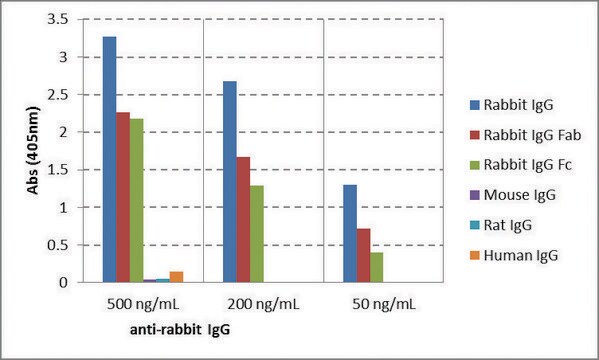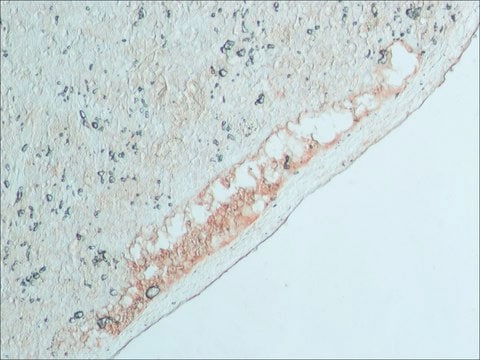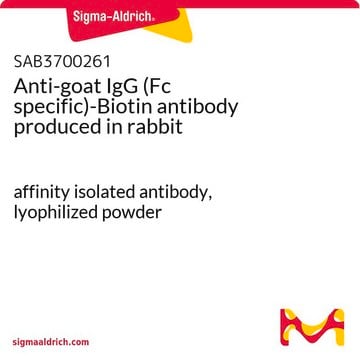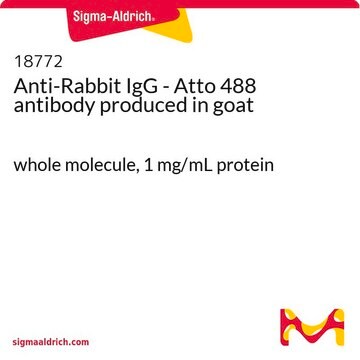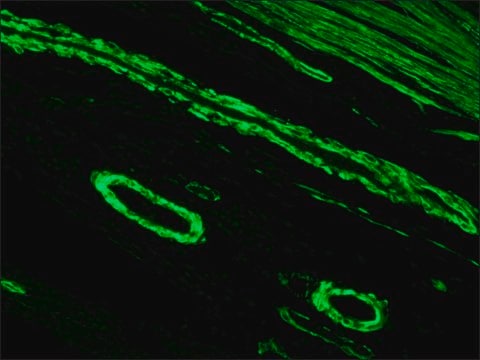AP187B
Goat Anti-Rabbit IgG Antibody, biotin-SP conjugate, Species Adsorbed
1.1 mg/mL, Chemicon®
Sign Into View Organizational & Contract Pricing
All Photos(1)
About This Item
UNSPSC Code:
12352203
eCl@ss:
32160702
NACRES:
NA.46
Recommended Products
biological source
goat
Quality Level
conjugate
biotin conjugate
antibody form
F(ab′)2 fragment of affinity isolated antibody
antibody product type
secondary antibodies
clone
polyclonal
species reactivity
rabbit
manufacturer/tradename
Chemicon®
concentration
1.1 mg/mL
technique(s)
ELISA: suitable
western blot: suitable
shipped in
wet ice
target post-translational modification
unmodified
Specificity
Rabbit IgG (H+L) (absorbed for minimal cross-reactivity to Human, Mouse and Rat Serum Proteins)
Application
Research Category
Secondary & Control Antibodies
Secondary & Control Antibodies
Research Sub Category
Secondary Antibodies Adsorbed for Dual Labeling
Secondary Antibodies Adsorbed for Dual Labeling
Suggested dilution for most applications:
1:50,000-1:1,000,000 for ELISA using enzyme-conjugated streptavidin
1:10,000-1:100,000 for western blotting with chemiluminescent substrates.
1:500-1:5,000 for enzyme immunoohistochemistry on tissue sections.
1:200-1:1,000 for flow cytometry and fluorescence immunohisto /cytochemistry
Optimal working dilutions must be determined by the end user.
1:50,000-1:1,000,000 for ELISA using enzyme-conjugated streptavidin
1:10,000-1:100,000 for western blotting with chemiluminescent substrates.
1:500-1:5,000 for enzyme immunoohistochemistry on tissue sections.
1:200-1:1,000 for flow cytometry and fluorescence immunohisto /cytochemistry
Optimal working dilutions must be determined by the end user.
This Goat anti-Rabbit IgG Antibody, biotin-SP conjugate, Species Adsorbed is validated for use in ELISA, WB for the detection of Rabbit IgG.
Physical form
Lyophilized. Buffer = 0.01 M Sodium Phosphate, 0.25 M NaCl, pH 7.6 with 15 mg/mL BSA, 0.01% Thimerosal and 0.05% Sodium Azide
RECONSTITUTION:
Reconstitute with 1.5 mL sterile distilled water.
RECONSTITUTION:
Reconstitute with 1.5 mL sterile distilled water.
Storage and Stability
Maintain lyophilized product at 2-8°C for up to 12 months. After reconstitution the product is stable for several weeks at 2-8°C as an undiluted liquid. For extended storage after reconstitution, add an equal volume of glycerol to make a final concentration of 50% glycerol followed by storage at -20°C with or without aliquotting for up to 12 months. Please note the concentration of protein (and buffer salts) will decrease to one-half of the original after the addition of glycerol.
Legal Information
CHEMICON is a registered trademark of Merck KGaA, Darmstadt, Germany
Disclaimer
Unless otherwise stated in our catalog or other company documentation accompanying the product(s), our products are intended for research use only and are not to be used for any other purpose, which includes but is not limited to, unauthorized commercial uses, in vitro diagnostic uses, ex vivo or in vivo therapeutic uses or any type of consumption or application to humans or animals.
Not finding the right product?
Try our Product Selector Tool.
Hazard Statements
Precautionary Statements
Hazard Classifications
Aquatic Chronic 3
Storage Class Code
11 - Combustible Solids
WGK
WGK 3
Certificates of Analysis (COA)
Search for Certificates of Analysis (COA) by entering the products Lot/Batch Number. Lot and Batch Numbers can be found on a product’s label following the words ‘Lot’ or ‘Batch’.
Already Own This Product?
Find documentation for the products that you have recently purchased in the Document Library.
Jing Ying Ma et al.
Journal of asthma and allergy, 1, 31-44 (2008-01-01)
p38 Mitogen-activated protein kinase (MAPK) plays a critical role in the activation of inflammatory cells. We investigated the anti-inflammatory effects of a p38α-selective MAPK inhibitor (SD-282) in a mouse transgenic (CC10:IL-13) asthma model. The CC-10-driven over-expression of IL-13 in the
Kelly Koral et al.
The American journal of pathology, 192(6), 887-903 (2022-04-08)
Activation of constitutive androstane receptor (CAR) transcription factor by xenobiotics promotes hepatocellular proliferation, promotes hypertrophy without liver injury, and induces drug metabolism genes. Previous work demonstrated that lymphocyte-specific protein-1 (LSP1), an F-actin binding protein and gene involved in human hepatocellular
Expression of hepatocyte epidermal growth factor receptor, FAS and glypican 3 in EpCAM-positive regenerative clusters of hepatocytes, cholangiocytes, and progenitor cells in human liver failure.
Hattoum, A; Rubin, E; Orr, A; Michalopoulos, GK
Human Pathology null
Jun Maeda et al.
Brain communications, 3(1), fcab011-fcab011 (2021-03-02)
Microglia are the resident phagocytes of the central nervous system, and microglial activation is considered to play an important role in the pathogenesis of neurodegenerative diseases. Recent studies with single-cell RNA analysis of CNS cells in Alzheimer's disease and diverse
Satyanarayana Medicherla et al.
The Journal of pharmacology and experimental therapeutics, 318(1), 99-107 (2006-04-11)
Mitogen-activated protein kinases (MAPKs) and heat shock proteins (HSPs) are ubiquitous proteins that function within T cells in both normal and stress-related pathophysiological states, including type 1 diabetes. The nonobese diabetic (NOD) mouse spontaneously develops T cell-mediated autoimmune pancreatic beta
Our team of scientists has experience in all areas of research including Life Science, Material Science, Chemical Synthesis, Chromatography, Analytical and many others.
Contact Technical Service

